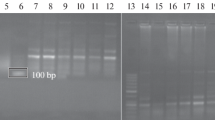Summary
Virulence patterns of yellow rust isolates collected in Kenya between 1986–1989 were compared with earlier results. The number of virulence factors per race and the range in virulence factors both increased considerably. Before 1976 races carried on average 4.5 to 5.0 virulence factors, whereas the races after 1986 had a mean of 6.5 virulence factors. The range in the number of virulence factors increased from some seven to eight in the first period to 12 in the second out of the 17 evaluated. In the period 1986–1989 another three virulence factors (2, 9 and A) were assessed. All three occurred at a high frequency.
Virulence neutralizing the resistance genes Yr2, Yr2+, Yr6, Yr6+, Yr7, Yr7+, Yr8, Yr9, Yr9+ and those in the cultivars Anza (A), Strubes Dickkopf (SD) and Suwon92/Omar (SU) occurred at a high frequency, while virulence for Yr3V, Yr4+, Yr5, CV and SP (resistance in Carstens V and Spaldings Prolific resp.) were not found. The remaining three virulence factors for Yr1, 10 and 3N were rare.
In the past ten years the resistance of most released cultivars became ineffective in less than six years. They were shown to carry race-specific major resistance genes such as Yr7+, Yr9+, SD and A. However, in the field, the resistance of the cultivars was not completely neutralized. A residual resistance, ranging from moderate to fairly high, was observed in all cultivars in which the major gene resistances were neutralized by corresponding virulence genes.
Other wheat cultivars such as Africa Mayo, Kenya Kudu, Enkoy, Kenya Leopard, Bounty, Frontatch, Bonny and Kenya Plume appeared to keep their resistance over a condiserable period of time. They are considered to be durably resistant to the Kenyan yellow rust populations. This form of resistance, together with the residual resistance, can be recommended for use in breeding programmes.
Similar content being viewed by others
References
Allison, C. & K. Isenbeck, 1930. Biologische Specialisierung von Puccinia glumarum tritici Erikss. und Henn. Phytopathologisch Zeitschrift 2: 87–98.
Bonthuis, H., 1985. Survival of stripe rust Puccinia striiformis on wheat in the Kenyan highlands and the consequences for virulence. Med. Fac. Landbouw Rijksuniv. Gent 50: 1109–1117.
Gerechter-Amitai, Z.K., C.H.van Silfhout, A. Grama & F. Kleitman, 1989. Yr15—a new gene for resistance to Puccinia striiformis in Triticum dicoccoides sel. G-25. Euphytica 27: 529–540.
Harder, D.E., 1971. Physiologic specialization and sources of resistance to wheat leaf rust in Kenya. Phytopathology 61: 1201–1204.
Johnson, R., 1978. Practical breeding for durable resistance to rust diseases in self-pollinating cereals. Euphytica 27: 529–540.
Johnson, R., R.W. Stubbs, E. Fuchs & N.H. Chamberlain, 1972. Nomenclature for physiologic races of Puccinia striiformis infecting wheat. Trans. Brit. Myc. Soc. 58: 475–480.
Line, R.F., 1978. Pathogenicity of Puccinia striiformis and resistance to stripe rust in the United States. Abstracts of papers, Third International Congress of Plant Pathology, Munich 1978, 305.
Macer, R.C.F., 1972. The resistance of cereals to yellow rust and its exploitation by plant breeding. Proc. R. Soc. Lond. B. 181: 281–301.
McNeal, F.H., C.F. Konzak, E.P. Smith, W.S. Tate & T.S. Russell, 1971. A uniform system for recording and processing cereal research data. United States Department of Agriculture, Agricultural Research Service Bulletin 34–121. 42 pp.
Nagarajan, S., 1983. Annual report 1983. Indian Agricultural Research Institute, Regional Station Flowerdale, Simla.
Parlevliet, J.E., 1983. Can horizontal resistance be recognized in the presence of vertical resistance in plants exposed to a mixture of pathogen races? Phytopathology 73: 379.
Peterson, R.F., A.B. Campbell & A.E. Hannah, 1948. A diagrammatic scale of estimating rust intensity on leaves and stems of cereals. Can. J. Res. 26: 496–500.
Stubbs, R.W., 1985. Stripe rust. In: A.P. Roelfs & W.R. Bushnell (Eds). The Cereal Rusts, Vol. II., pp. 61–101. Orlando, Florida, Academic Press, New York.
Stubbs, R.W., 1988. Pathogenicity analyses of yellow (stripe) rust of wheat and its significance in a global context. In: N.W. Simmonds & S. Rajaram (Eds). Breeding Strategies for Resistance to the Rusts of Wheat, pp. 23–28. CIMMYT, Mexico.
Stubbs, R.W., E. Fuchs, H. Vecht & E.J.W. Basset, 1974. The international survey of factors of virulence of Puccinia striiformis Westend in 1969, 1970 and 1971. Stichting Nederlands Graan-Centrum, Technisch Bericht 21, 88 pp.
Van Dijk, P., J.E. Parlevliet, G.H.J. Kema, A.C. Zeven & R.W. Stubbs, 1988. Characterization of the durable resistance to yellow rust in old winter wheat cultivars in the Netherlands. Euphytica 38: 149–158.
Wellings, C.R. & R.A. McIntosh, 1990. Puccinia striiformis f.sp. tritici in Australasia: pathogenic changes during the first 10 years. Plant Pathol. 39: 316–325.
Zadoks, J.C., T.T. Chang & C.F. Konzak, 1974. A decimal code for the growth stages of cereals. Weed Res. 14: 415–421.
Zeller, F.J., 1973. IB/IR wheat rye chromosome substitutions and translocation. Proc. of the Fourth Int. Wheat Genetics Symp., Columbia, 209–222.
Author information
Authors and Affiliations
Rights and permissions
About this article
Cite this article
Danial, D.L., Stubbs, R.W. & Parlevliet, J.E. Evolution of virulence patterns in yellow rust races and its implications for Ereeding for resistance in wheat in Kenya. Euphytica 80, 165–170 (1994). https://doi.org/10.1007/BF00039647
Received:
Accepted:
Issue Date:
DOI: https://doi.org/10.1007/BF00039647



